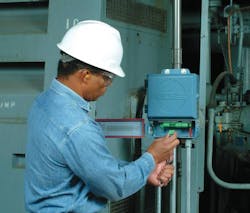A couple of years back, when the Austin, Texas-based Emerson Process Management announced its Asset Management Software (AMS) suite of applications and Web portal, President John Berra predicted a time when all process plant assets could be monitored under the same solution suite. That prediction came a step closer to reality with the March 4th launch, at a press event held at the Kennedy Space Center in Cape Canaveral, Florida, of the company’s smart machinery health management system, highlighted by the new CSI 9210 smart transmitter.
In short, the introduction extends Emerson’s PlantWeb architecture into machinery health by embedding neural network technology in a transmitter that’s intimately connected, over Foundation Fieldbus, to the process management intelligence in AMS. The end result is a “black box” that monitors the health of critical motor-pump assemblies throughout the plant, delivering real-time diagnostics, PlantWeb alerts, actionable work orders and even a “machine health” value, ranging from 1 percent to 100 percent.
Playing chess blindfolded
Notes Berra, “This launch is another major step in the PlantWeb journey of helping our customers improve their bottom-line performance.” The new system can help Emerson customers reduce unplanned shutdowns, which can cost 7 percent of a plant’s capacity, Emerson said. Other potential benefits include cutting rework in half to double profits, and minimizing downtime to manage quality and safety issues.
“A plant manager can stand in the middle of the plant and have no idea if it’s running at peak efficiency,” says Berra. “It’s like playing chess blindfolded.”
Emerson sources Marsh & McLennan Protection Consultants with the following: 43 percent of plant incidents are caused by mechanical failure; there are 2,500 machines in a typical process plant; and unplanned shutdowns account for the largest cost losses in the process industries.
The CSI 9210 is intended to close the gap on incidents and shutdowns, by automating data collection and analysis, and integrating decision support for every level of user. Adds Berra, “You don’t need a Ph.D. in vibration analysis to use this equipment.”
“Everything degrades with time,” says Brian Humes, vice president and general manager, Emerson machinery health management, in Knoxville, Tenn. “The key is to get advance warning so you can catch problems before they occur and increase the time to respond.”
Known failure modes
According to Emerson, most online vibration monitoring systems will send alarms when overall vibration levels increase, but to get more sophisticated information, the user must employ expert spectral frequency analysis. There are known failure modes in the vibration data at very specific frequencies, for faults such as imbalance, bearing wear and cavitation. Using multiple sensor inputs, including thermocouples and accelerometers, and embedded fuzzy logic diagnostic algorithms, the CSI 9210 translates data into actionable information that can be used by personnel to run the plant.
Says Todd Reeves, marketing manager for machinery health management, “In the past, process plants have focused machine health monitoring on large compressors and turbines. Falling through the cracks are the motor-pump trains, yet they comprise 60 percent of a plant’s machines.”
Priced from $5,000 to $7,000 per unit, the CSI 9210 machinery health transmitter addresses the motor-pump combination with a packaged solution that relates real-time data to the condition of the process and the product being manufactured. As an integral part of the PlantWeb architecture, information from the transmitter can be routed to operations, maintenance and management.
Emerson test sites for the CSI 9210 include chemical, power and paper plants. Craig Llewellyn, president of Emerson’s Asset Optimization Division, in Eden Prairie, Minn., says users will identify the most critical motor-pump trains in a plant, and apply a CSI 9210 to each of those. “We believe a typical installation will have about 100 units per plant.”
About the Author
Jane Gerold
Automation World

Leaders relevant to this article:
